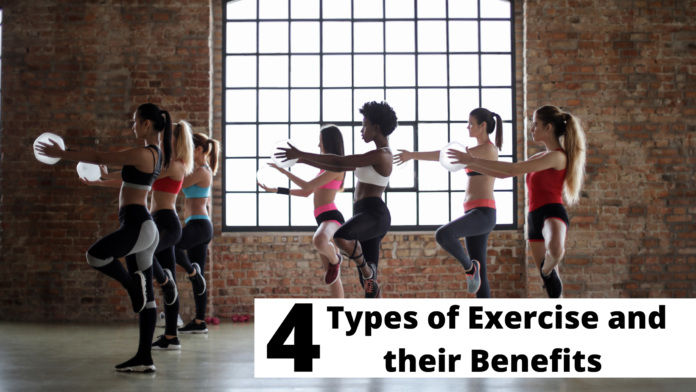There are four fundamental forms of core muscle group exercise – aerobics, strength, flexibility, and balance. We should incorporate them into our daily physical fitness schedule and adopt a versatile, mixed training routine. Engaging in 30 minutes or more of moderate physical activity daily significantly lowers the risk of morbidity and mortality from chronic diseases, such as cardiovascular disease, stroke, diabetes, respiratory disease, and cancer. Daily workouts can substantially promote mental well-being and improve quality of life by alleviating anxiety and depression, improving memory and concentration, and ensuring a good night’s sleep.
Let’s look at the four basic kinds of exercise and their benefits.
1. Cardiovascular or aerobic exercises: Cardio exercise involves large muscle group movement over a sustained period, raising your heart rate and breathing rate to moderate to vigorous intensity for a minimum of 10 minutes.This increase in cardio-respiratory rate relaxes your blood vessels (arteries, veins, capillaries), enhances the transport of oxygen and nutrients to all the tissues in your body, lowers levels of LDL or “bad” cholesterol, and raises levels of HDL or “good” cholesterol.
A frequency of three days a week is recommended to optimize the benefits of cardio exercise, which include:
- Improved heart health and circulatory system
- Enhanced brain health
- Increase in metabolic rate
- Weight regulation
- Strong immune system
- Reduced arthritis-related pain and joint stiffness
If you are a beginner, you can start with low-to-moderate intensity activities, such as walking, bicycling, dancing, jogging, skating, golfing, and water aerobics. Increasing the intensity of the workout over time is preferable to increasing the volume or length of the activity.
Cardio exercises are a great way to develop stamina and endurance over time.
2. Strength Training: The primary purpose of strength training exercises is to build lean muscle mass and strength in core muscle groups in the arms, legs, torso, back, hips and thighs. Examples of strength training workouts include weight training, squats, push-ups, sit-ups, hiking, trekking, and mountain climbing.
3. Flexibility Exercises: Flexibility exercises are stretching motions that help maintain inherent muscle flexibility and smooth mobility and avoid deterioration stemming from factors like increasing age, sports injuries, or physical overexertion. These exercises enhance muscle length, elasticity, power and promote a broader range of motion. Overall, muscular resilience to physiological wear and tear, as well as injuries, increases.
The most widely performed flexibility exercises consist of different forms of stretching, yoga, and pilates.
Although stretching before engaging in an exercise routine is strongly recommended, daily “simple stretching,” irrespective of physical activity, is equally important. Simple stretches can amplify the range of motion in your joints and benefit you by:
- Improving posture: Tightness in the chest, back, and hip muscles can contribute to poor posture. Stretching muscle groups in these regions can improve posture while sitting or standing for long hours. Stretching regularly after sitting at your computer or laptop for long hours can also help decrease back pain.
- Decrease muscle discomfort, soreness and prevent injury (sprains, strains): Stretching before physical activity increases blood flow to the muscles and warms them up, which in turn lessens muscle tension and lowers the risk of muscular soreness, tear(s), or other forms of injury.
4. Balance Movements: Balance movements strengthen the inner muscles responsible for maintaining muscular coordination and equilibrium, thereby improving body posture and stability and enhancing hand-eye coordination to avert the risk of injuries.
Examples of balance exercises for improved posture and stability include:
- Standing up with total body weight on one leg and raising the other.
- Walking briskly and lifting the knees high.
- Raising the body on toes and holding it.
- Placing one foot right in front of the other and covering a considerable distance.
Therefore, these four different types of physical exercises can fortify your musculoskeletal system, making you look and feel great!
Well-balanced nutrition and physical fitness are cornerstones of a healthy mind and body. A preventive health screening can provide you with a clinical picture of your OVERALL health byassessing your risk for chronic medical conditions, detecting their onset and progression, and designing and monitoring personalized management approaches.
Apollo ProHealth is India’s first personalized, predictive preventive health screening program with health risk assessments curated just for you to guide targeted intervention, continuum of care, and a path to wellness. Join today!


















